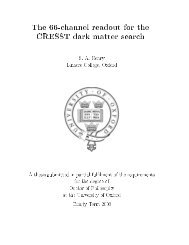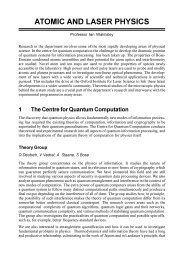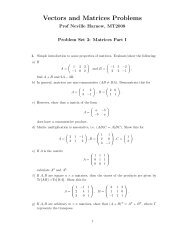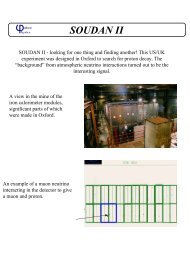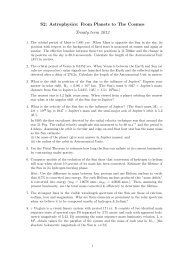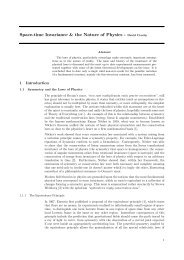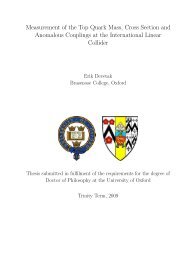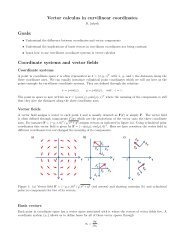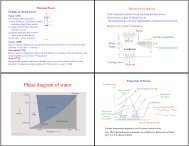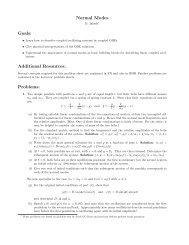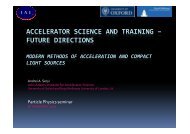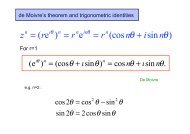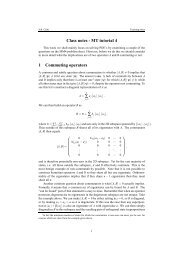MPhys cover_19September2011.indd - Department of Physics ...
MPhys cover_19September2011.indd - Department of Physics ...
MPhys cover_19September2011.indd - Department of Physics ...
You also want an ePaper? Increase the reach of your titles
YUMPU automatically turns print PDFs into web optimized ePapers that Google loves.
A&L06 An optical system for “stem cell farming” –<br />
growing new hearts<br />
Current research in regenerative medicine involves harvesting<br />
stem cells at critical phases <strong>of</strong> their development into<br />
specific cell types. Adult stem cells (i.e. stem cells derived<br />
from adult cells rather than embryonic cells) can be induced<br />
to develop as cardiac myocytes when appropriate stresses<br />
are applied at certain stages <strong>of</strong> their development. Very little<br />
is known about how, when and why the cells differentiate<br />
into the various types required for a complete organism.<br />
Nonetheless recent progress has allowed the growing <strong>of</strong><br />
cardiac myocytes and it is now important to provide a reliable<br />
source <strong>of</strong> cells at the appropriate culture stage and to<br />
identify and separate them into purified colonies. At present<br />
the research is significantly limited by having to separate the<br />
cells manually. The project will investigate the possibility <strong>of</strong><br />
using diffraction <strong>of</strong> laser light from the cell cultures to identify<br />
automatically cells colonies as a precursor to automatic<br />
labelling and separation. An alternative approach using image<br />
processing s<strong>of</strong>tware will also be investigated.<br />
Knowledge <strong>of</strong> 2nd year Optics will be sufficient and computer<br />
expertise will be a distinct advantage.<br />
Supervisor : Pr<strong>of</strong> P Ewart <strong>Physics</strong> Tel No : 272340<br />
Email : p.ewart@physics.ox.ac.uk<br />
A&L07<br />
Quantum entanglement as a form <strong>of</strong> curvature<br />
This project will apply the standard methods <strong>of</strong> gauge field<br />
theory – namely, the Wilson loop – to study entanglement<br />
between many quantum bits. Entanglement will thus be<br />
seen as a form <strong>of</strong> curvature that arises as quantum measurements<br />
are parallel transported using many qubit states as the<br />
underlying base. Understanding many body entanglement<br />
is important both from the perspective <strong>of</strong> the developing<br />
quantum technologies as well as from the fundamental angle<br />
<strong>of</strong> probing the boundary (if such a thing exists) between the<br />
quantum and classical worlds.<br />
Supervisor : Pr<strong>of</strong> V Vedral <strong>Physics</strong> Tel No : 272389<br />
Email : v.vedral@physics.ox.ac.uk<br />
A&L08 DNA as a (quantum) measurement apparatus<br />
Based on a very simple model <strong>of</strong> the DNA (a coupled chain<br />
<strong>of</strong> quantum harmonic oscillators) we have recently found<br />
that electron clouds centred on nearest neighbouring base<br />
pairs are, in fact, quantum entangled. This entanglement is<br />
<strong>of</strong> the standard Einstein-Podolsky-Rosen type, namely in<br />
the position (and momentum) degrees <strong>of</strong> freedom. This is<br />
surprising, but is this entanglement important for the functioning<br />
<strong>of</strong> DNA? This project will investigate how to model<br />
mutations in the DNA due to absorption <strong>of</strong> a single quantum<br />
<strong>of</strong> radiation as interaction between the quantized harmonic<br />
chain representing DNA and the incoming quantized radiation.<br />
It belongs to a growing field <strong>of</strong> quantum biology, whose<br />
importance is seen in realising that some bio-processes simply<br />
cannot be understood properly (or even at all) without<br />
the full machinery <strong>of</strong> quantum mechanics.<br />
Supervisor : Pr<strong>of</strong> V Vedral <strong>Physics</strong> Tel No : 272389<br />
Email : v.vedral@physics.ox.ac.uk<br />
A&L09 Studies <strong>of</strong> super-luminal wave-front propagation<br />
Light waves propagate in free space with a constant phase<br />
velocity c. Whilst this well-known statement is true for<br />
plane waves, it does not always hold for more complicated<br />
waves, such as those with transverse structure. A well-known<br />
manifestation <strong>of</strong> this is the Gouy phase shift experienced by<br />
a focused beam.<br />
In this project the super-luminal propagation <strong>of</strong> light waves in<br />
the shadow <strong>of</strong> an opaque disc is investigated experimentally.<br />
Interferometric techniques will be used to measure the phase<br />
velocity <strong>of</strong> the waves in the region <strong>of</strong> the Poisson spot as a<br />
function <strong>of</strong> position behind the disc. Phase velocities up to<br />
approximately 1.2 c are expected.<br />
The project will involve setting up an interferometer and<br />
interfacing a CCD camera with a computer. The student<br />
will have to write computer programs to extract the two<br />
dimensional phase <strong>of</strong> the diffracted wave-front from the<br />
interference pattern. If time permits, numerical calculation<br />
<strong>of</strong> the Fresnel diffraction pattern behind the disc could be<br />
undertaken. These will be used to compare directly the measured<br />
and calculated two-dimensional interference patterns.<br />
A description <strong>of</strong> the experimental method, and further relevant<br />
references, may be found in: M. Vasnetsov et al. Optics<br />
Letters Vol. 32 p. 1830 (2007).<br />
Supervisor: Pr<strong>of</strong> S Hooker <strong>Physics</strong> Tel No: 282209<br />
Email: s.hooker@physics.ox.ac.uk<br />
Laser development for efficient plasma genera-<br />
A&L10<br />
tion<br />
Laser plasma acceleration is a new method <strong>of</strong> producing a<br />
very high gradient accelerating field that has been successfully<br />
used to generate 1 GeV beams <strong>of</strong> electrons with a small<br />
energy spread. This method is being studied intensively as it<br />
has the potential to replace current rf accelerating technology<br />
and drastically reduce the length <strong>of</strong> high energy accelerators<br />
from the km to the m scale. Most current research in laser<br />
plasma acceleration focuses on using a very high energy,<br />
ultrashort laser pulse (1018 W/cm2) to produce the plasma<br />
from a low density gas, requires access to national scale<br />
specialist laser facilities. However, it has been shown that<br />
efficient excitation <strong>of</strong> a plasma wave may also be achieved by<br />
a train <strong>of</strong> multiple laser pulses <strong>of</strong> lower energy, with adjustable<br />
pulse durations and separations (ref?). In this project, the<br />
student will be investigating methods <strong>of</strong> generating suitable<br />
trains <strong>of</strong> pulses from a laser oscillator producing identical<br />
pulses at a regular frequency. Making variable pulse trains<br />
from such a source may involve splitting the pulse trains<br />
and recombining them in fibre, or using other techniques as<br />
necessary. This project will be predominantly experimental<br />
in nature, using lasers and fibre optics, and it may be helpful,<br />
but not necessary if the student has taken the S19 option in<br />
accelerator science, the S16 option in plasma physics or the<br />
C2 course in laser physics.<br />
Supervisor : Dr L Corner <strong>Physics</strong> Tel No : 273470<br />
Email : l.corner@physics.ox.ac.uk<br />
20




